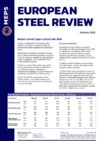Mill capacity cuts fail to deliver price aspirations
In early September, European steelmakers were promoting significant price increases, to protect margins against soaring energy costs. This effort was supported by blast furnace shutdowns and other capacity cuts. After gaining initial traction, prices weakened once more. By the start of October, they had returned to September levels and faced continued downward pressure.
The steel producers’ attempts to raise selling values met with firm resistance from buyers. Stock levels are high, relative to current demand, which is below forecast and shows no signs of recovery. Customers are also suffering from high energy costs and restricting production. Purchasing decisions can be deferred, in anticipation of further steel price cuts.
Despite announced output reductions, buyers confirm that availability is still good and domestic delivery lead times are shorter than normal. Mill sales representatives are eager to secure orders but are undermining their own price aspirations. Steelmakers are reportedly selling at, or in many cases below, break-even point.
Competitive offers, from East Asia, also act as a drag on European steel prices. Turkish producers, facing high energy costs, are making targeted offers to EU purchasers. With only small volumes to place, however, buyers’ interest in such offers, for supply in early 2023, is limited.
The fear of energy cost spikes in the coming winter was the main driver behind mills’ efforts to raise prices. Most European governments have now stated their intention to cap costs, although details are sparse. This has weakened one argument used by producers to justify higher offers, even if they have not fully covered previous increases. Relatively stable raw material costs also limit the scope for upward price movement.
The EuroBLECH exhibition takes place, in Hanover, at the end of this month. Traditionally, this is a forum for agreeing flat product contract prices for the first quarter or first half of the coming year. Many participants are optimistic that it will mark a turning point. Several, however, are sceptical about any positive movement, given the underlying lack of demand. Automotive production remains at a relatively low level and white goods manufacturers are booking well below typical tonnages.
Nonetheless, most European distributors are sanguine about the current situation. Margins have been very good so far, this year. The goals are to minimise losses until the year-end and control stocks, to provide a stable base for 2023.

Source:
European Steel Review
The MEPS European Steel Review is an informative, concise and easy-to-use monthly publication, offering unique professional insight into European carbon steel prices.
Go to productRequest a free publication





